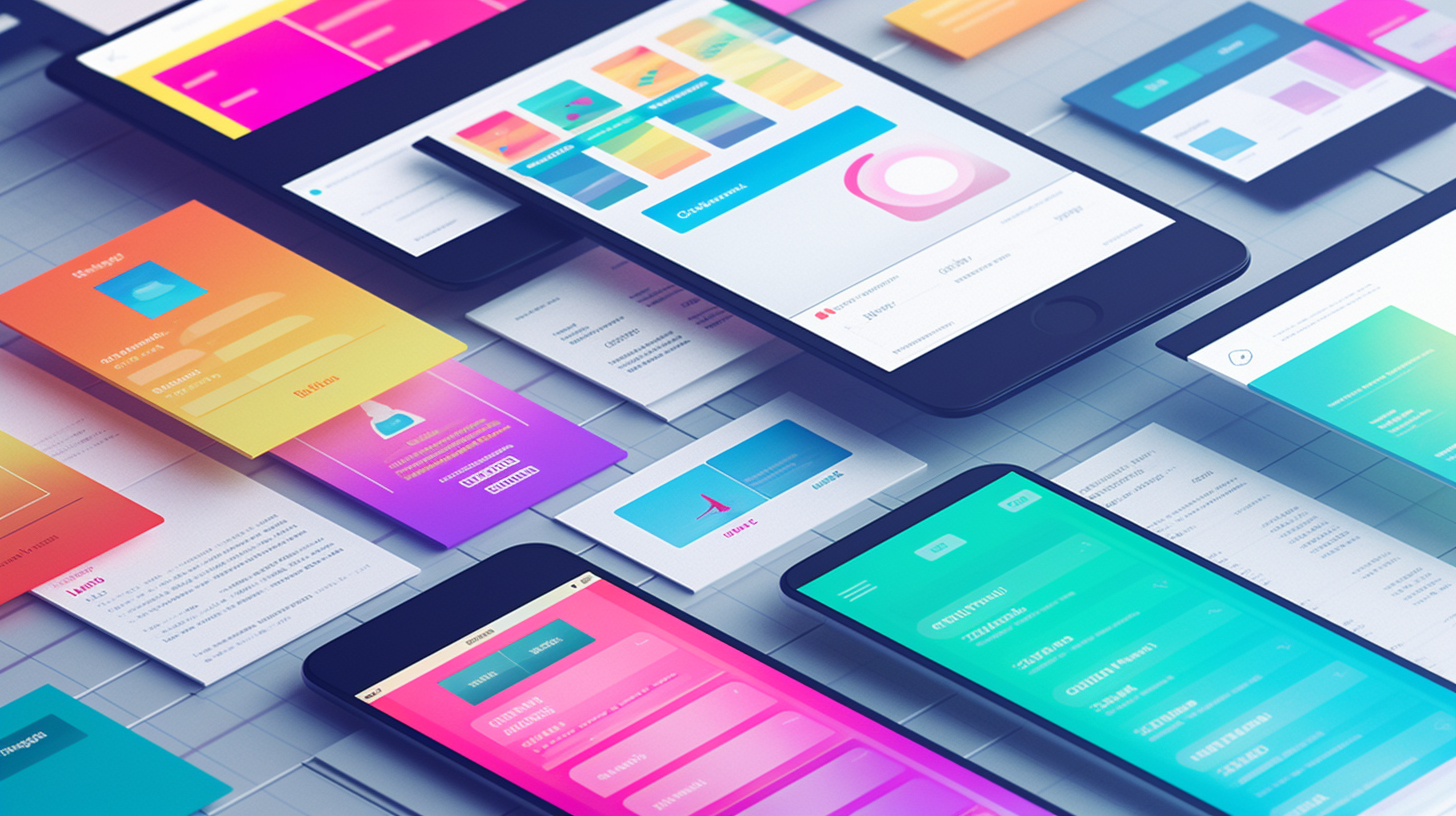Learn how Anthroware is elevating UI/UX research and design by extracting, synthesizing, visualizing, and distributing qualitative & quantitative data.
Table of Contents:
- Introduction: Understanding UI/UX Research & Design
- Anthroware's Unique Approach to UI/UX Research & Design
- Best Practices in Human-Centered UI/UX
- Tactical Guide: Applying UI/UX Research to Your Business
- Conclusion: The Future of UI/UX Research & Design
Introduction: Understanding UI/UX Research & Design
I'm part of the dynamic team here at Anthroware, and I'm thrilled to delve into the fascinating world of UI/UX research and design with you. Having witnessed firsthand the transformative power of thoughtful UI/UX design, I can confidently say it's the secret sauce that can catapult your digital product to unprecedented success and help nail product-market fit.
The Importance of UI/UX in Digital Products
Think about the last app you fell in love with. What made it so great? Was it the eye-catching visuals, the intuitive navigation, or the satisfying click of a well-designed button? All of these elements are part of the UI/UX design tapestry. They're the cogwheels behind your seamless digital experiences.
UI/UX design is the lifeblood of any digital product company. It's the bridge that connects users to the technology, making complex processes feel simple, natural, and enjoyable. It's not just about making things look pretty; it's about creating a user-centered design that feels intuitive to navigate and actually solves a problem in the user's life. A truly successful digital product not only meets user expectations but exceeds them - this is the magic that stellar UI/UX design brings to the table. A product that behaves exactly the way you expect it to, exactly when you expect it.
What Does UI/UX Research & Design Entail?
Delving deeper into UI/UX research and design, it's a meticulous, multi-faceted process. If done right, it starts with understanding the user – their behaviors, preferences, and pain points. This is where we use our detective hats, employing methods like user interviews, surveys, interactive workshops, session recordings, and usability testing to gather data.
Next, we synthesize these insights into actionable points that can guide the design process. Nowadays, we even have capabilities that some AI companies have such as the use of Large Language Models (LLM) to help us synthesize our data. Every button placement, color selection, and transition is an informed decision rooted in data and user understanding. But our job doesn't stop there! Post-launch, we continue to monitor user interaction, adjusting and refining the design as needed to ensure it continues to deliver an optimal user experience. The UI/UX design process is iterative and ever-evolving, just like the digital world we're all a part of.
The Impact of UI/UX on Business Success
In our highly competitive digital marketplace, a good UI/UX design can be your winning edge. It can enhance user satisfaction, drive engagement, and boost retention. After all, happy users are more likely to turn into loyal customers, right?
But the impact goes even further. A well-researched and well-executed UI/UX design can streamline your business operations, reducing development costs and time by preventing unnecessary iterations. It can increase your product's marketability, making it a more appealing choice for potential users.
At Anthroware, we've seen these digital transformations happen with our clients. We've seen businesses flourish when they put the user at the heart of their design. That's why we're so passionate about what we do, and why we believe that UI/UX research and design is a game-changer in the world of digital products.
So, buckle up, and join us on this journey of exploring the impact, importance, and potential of UI/UX research and design!
Anthroware's Unique Approach to UI/UX Research & Design
Let's explore how we at Anthroware apply our unique flair to the science and art of UI/UX research and design. In our experience, true innovation emerges from deep understanding, open-minded exploration, and a touch of the unexpected. That's why our approach is a bit different, a bit daring, and always user-focused. These are usually important considerations when deciding on a software consulting firm to partner with.
Extracting Data from End-Users with Interviews, Surveys, and Workshops
Our journey begins with our most valuable resource – you, the user. We're not just designers or researchers, but also diligent listeners. We leverage a blend of interviews, surveys, and interactive workshops to paint a vivid picture of your users and their experience while using your products. These are the same tactics that encouraged us to start our win-loss business unit!
Interviews allow us to dive deep into your thoughts, feelings, and experiences. We don't just stick to a rigid script – instead, we strive to create an open dialogue where you feel comfortable sharing your insights. Surveys and general market data, on the other hand, help us quantify your experiences, providing large-scale data that captures the wider user sentiment.
Lastly, our interactive workshops break down the wall between designer and user. We invite you into the design process, empowering you to shape the solutions that ultimately serve you. It's a hands-on, collaborative approach that sparks innovative ideas and strengthens our shared understanding.
Combining Quantitative and Qualitative Datasets
The magic happens when we bring these diverse data strands together. By combining the depth of qualitative insights with the breadth of quantitative data, we're able to create a well-rounded view of the user experience.
Our consultants and UX researchers collaborate closely to meld these datasets into a cohesive narrative. The hard numbers meet the human stories, resulting in a 360-degree understanding of our users. It's a powerful combination that drives our design philosophy.
Visualizing User Experience Insights
Now, what good are insights if they can't be understood and acted upon? That's where visualization comes in. We transform the intricate web of data into clear, intuitive visuals that everyone on the team can grasp and use.
Whether it's a user journey map highlighting friction points or a heatmap showing click patterns, our visuals are designed to bring the user experience to life. These illustrations are the roadmap guiding our design process, making sure every decision is rooted in user reality.
Using Research to Drive Design Decisions
At Anthroware, research isn't an afterthought or a mere validation tool. It's the rudder steering our design ship. Every color, layout, and interaction is a direct result of the insights gathered through our research. We've written quite a bit about human-centered design and painted exemplary design pictures of what to look for in a successful design.
When the research is so deeply ingrained in our process, the resulting design feels intuitive, looks delightful, and works flawlessly. It's how we ensure that our solutions don't just look good on paper, but also resonate with real users in the real world.
This, in essence, is the Anthroware way – a symbiotic dance of research and design, driven by a profound respect for the user. And we're just getting started! We're glad you've joined us as we continue our journey into the captivating world of UI/UX research and design.

Best Practices in Human-Centered UI/UX
As we peel back the layers of UI/UX research and design, we encounter the pulsating heart of our craft: the human user. At Anthroware, we hold a simple truth dear: the user should always be front and center in every aspect of design. Here, let me take you through some of the best practices in creating human-centered UI/UX that we follow religiously.
The approach of UI/UX design that prioritizes the human experience involves generating solutions to issues by incorporating human viewpoints at every stage of the resolution process. Babich, Nick. “Top 4 Principles of Human-Centered Design.” Medium, 12 Aug. 2020, uxplanet.org/top-4-principles-of-human-centered-design-5e02751e65b1.
Balancing User Needs and Business Goals
It's like walking a tightrope, isn't it? On one end, we have the user's needs, desires, and frustrations; on the other, the business goals, objectives, and constraints. The trick is to navigate this fine line without compromising on either side. Some might call us customer-obsessed because of how granular our approach is to our engagements when we try to get from one end of this tightrope to the next.
We achieve this by fostering a collaborative environment where every stakeholder – from the user to the product manager – has a say. We constantly iterate and adapt our designs based on user feedback while ensuring alignment with the business goals. It's not always easy, but it's this challenge that makes our work so exhilarating!
Techniques for Effective User Research
Digging into the core of user needs demands more than a one-size-fits-all approach. Effective user research requires a combination of methods and tools that help us unravel the layers of user experience.
Think of it as a toolkit - our mixed bag of surveys, in-depth interviews, and contextual inquiries. We also use participatory design sessions that give users a seat at the design table. And of course, let's not forget usability testing, the unsung hero that spots those pesky design flaws before they reach the user.
Each technique is chosen based on the research question at hand, the stage of the design process, and the resources available. This flexibility allows us to stay attuned to the user's voice throughout the entire design process.
Designing for Usability and Engagement for Happy and Delighted Humans
Nothing beats the satisfaction of seeing a user effortlessly interact with our design, their face lit up with a smile. Usability and engagement are the dual forces that drive delightful user experiences and ultimately the icing on the cake for how we innovate with product development.
Usability ensures our design is easy to understand and use. It's about removing friction, reducing cognitive load, and making the interaction flow as smoothly as a quiet brook. Engagement, on the other hand, infuses an emotional layer into the experience. It's what hooks the user, compels them to explore, and ultimately, leaves them delighted.
Weaving these elements together requires a deep understanding of human psychology, an empathetic mindset, and a dash of creativity. But the reward – happy, delighted humans – is worth every ounce of effort!
In the realm of UI/UX research and design, human-centered practices guide us, reminding us that behind every click, swipe, or scroll, there's a human trying to achieve a goal, solve a problem, or fulfill a need. And as we design with this in mind, we create experiences that not only serve users but also enchant them. It's where the "Anthro" comes from in Anthroware!
Tactical Guide: Applying UI/UX Research to Your Business
No fluff, no jargon, just practical, actionable insights that you can apply in your business today. The world of UI/UX research and design is vast and expansive, but here, I’ll guide you through some of the key steps that you can implement right away.
Identifying Opportunities for Improvement through User Research
The first step to any effective UI/UX improvement strategy is understanding where you currently stand. Don't just guess or make assumptions—unearth those insights with good ol' user research.
Capture your user's behavior, analyze their patterns, and understand their needs and frustrations. As I already mentioned, this could be as simple as launching an online survey or as in-depth as conducting user interviews and usability testing. The aim? To grasp their pain points, their wishes, and their “if only” moments. This treasure trove of insights uncovers those gold nuggets of opportunity just waiting to be seized.
Implementing User-Centered Design Principles
Armed with these insights, it's time to bring the user into the heart of your design process. User-centered design is not just a buzzword we throw around in the industry—it's a philosophy, a mantra, and a way of life here at Anthroware.
Start with user personas, empathy maps, and journey maps that encapsulate your user’s experiences. Use these tools to guide your design decisions and to ensure alignment with user needs and expectations. Remember, every design element, every interaction, every pixel should serve a purpose: to make the user's life easier and their experience delightful.
5 Ways to Evaluate and Improve Your UI/UX Design
Finally, let's take a gander at the top five strategies to evaluate and enhance your UI/UX design (often these are some of the reasons we're chosen as the "ideal" software development partner):
- Usability Testing: This is your reality check. It’s one thing to create a design, but how does it fare when faced with real users and real tasks? Usability testing shines a spotlight on areas of friction and provides actionable insights to improve.
- Heatmaps and Analytics: Dive into the data! Heatmaps and analytics provide objective evidence of user behavior. Where are users clicking? Where are they spending the most time? The answers lie in the data.
- A/B Testing: Can't decide between two design options? Let the users decide! A/B testing allows you to compare and contrast, ultimately leading to a design that best serves your users.
- Accessibility Checks: Inclusivity is not optional; it's a must. Use automated tools and manual checks to ensure your design is accessible to everyone.
- Iterative Design: UI/UX design is never one-and-done. It’s a cyclical process of design, test, and refine. The key is to stay agile and receptive to feedback.
And there you have it—a tactical guide to implementing UI/UX research and design principles in your business. It's a journey, a process, and at times a challenge, but the reward—improved user experience, increased user satisfaction, and ultimately, business success—makes it all worthwhile.
Conclusion: The Future of UI/UX Research & Design
As we bring this discussion to a close, I can't help but reflect on the journey we've traveled, the challenges we've faced, and the triumphs we've celebrated in the world of UI/UX research and design here at Anthroware. It's been a thrilling ride so far attempting to make the best customer experience possible!
Harnessing Data-Driven Insights
In the complex maze of UI/UX, data has proven to be our guiding light, steering our decisions, illuminating hidden paths, and showing us where we stand. At Anthroware, we've always championed a data-driven approach, unearthing valuable user insights through quantitative and qualitative research, surveys, interviews, and workshops.
Empowering Businesses through UI/UX Design
It's not just about us. It's about the businesses we serve, the teams we collaborate with, and the users we design for. At the end of the day, good UI/UX design isn't just about aesthetics or functionality—it's about business success.
Through our work, we've seen firsthand how intuitive design and empathetic user research can enhance engagement, boost conversions, and elevate user satisfaction. These are not just design victories; they're business victories. And they're tangible proof of the power of UI/UX design to create meaningful change.
Looking Ahead
As we stand at the precipice of tomorrow, we can't help but be excited for the future of UI/UX research and design. With emerging technologies, evolving user expectations, and an increasingly digital world, the canvas of UI/UX design is expanding at a breathtaking pace.
And at Anthroware, we're ready to meet these challenges head-on. As innovators and pioneers, we're eager to push boundaries, explore new frontiers, and continue learning and growing in this ever-changing landscape.
So, as we wrap up this discussion, let's look to the future with anticipation and resolve, especially with the new advancements in AI & LLM. Let's continue to elevate the field of UI/UX research and design, leveraging our data-driven insights, our user-centric philosophy, and our relentless passion to craft digital experiences that resonate, solutions that matter, and designs that truly make a difference. Here's to the future of UI/UX research and design—let's shape it together!










